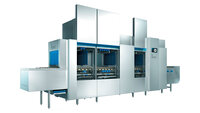Have you ever wondered how commercial dishwashers work, and how their performance affects the performance of restaurants, canteens, hotel chains?
As is well known, commercial dishwashers are the main allies of professionals in the gastronomy, and the quality of their operation is a key factor in the smooth and punctual performance of an infinite number of daily activities. As a rule, large structures, such as restaurants and hotels, which serve hundreds of covers a day, opt for advanced solutions such as flight type dishwashing machines, which ensure maximum organisation and fast and optimal management of dishes of all types.
COMMERCIAL DISHWASHERS: HOW DO THEY WORK?
Commercial dishwashers are therefore used not only in large catering chains, but also on cruise ships or hospitals, and the reason is simple: they simplify, speed up and improve the wash cycles, both in terms of quality and level of hygiene. And there's more: more than anything else, the operation of commercial dishwashers is based on the reliability of the equipment, which must be able to withstand high workloads and constant stresses.
However, the operation of ´commercial dishwashers should not only be seen in the context of performance, but also in relation to other specific factors, which may include:
- Size
- Specific features
- Technology used
What must remain constant is their ability to fully satisfy the washing needs of the structures in which they are installed.
Commercial dishwashers feature complete cycles from automatic washing to drying, much faster than standard dishwashing machines. The completeness of the washing and their speed are due to their main feature: the path that the dish runs through on the conveyor belt. Generally, from the moment the operator places the dishes on the conveyor belt, there are several passages or, rather, different zones:
- Loading area: the washing operator places the dirty dishes on the conveyor belt, chosen specifically based on the type of dishes to be washed;
- Pre-washing area: the dishes are automatically transported by the conveyor belt into the pre-washing area where coarse dirt is removed;
- Washing area: once the most important dirt has been removed, the actual washing of the dishes takes place in this area. In the case of specific dishes or activities, the design of more than one washing area is evaluated;
- Rinsing area: once the washing(s) has/have been completed, the dishes are rinsed with clean water at a temperature that ensures that it is sanitised (depending on its composition: glass, porcelain or steel);
- Drying area: once rinsed, the dishes are dried with constant hot air flows;
- Discharge area: the dishes reappear in front of the operator clean and dry always resting on the conveyor belt, ready for reuse or storage.
In addition to the zones described above, there are the so-called neutral separation zones with the function of separating, for example, the pre-washing zone from the washing zone, or the washing zone from the rinsing zone, in order to avoid water contamination and always to guarantee the highest hygienic levels.
In this way, this equipment minimises the possibility of rings and stains on the crockery, reducing the manual operations by the staff involved and thus speeding up all operations in the kitchen.
In general terms, the washing and rinsing phases of commercial dishwashers are based on filling the tanks with water, heated by its own internal resistance, and on "draining" the detergent from the tank. Dosage of the detergent is usually done with the help of automatic dosers, where possible. Once the high temperature washing has been completed, the commercial dishwasher will drain some of the water used and replace it with clean water, with which it will rinse the dishes. In this operating phase, rinse aid will also be added, designed to protect the crockery with a special water-repellent "film", which will prevent the production of stains and rings on the surfaces.
MEIKO: PRODUCERS OF COMMERCIAL DISHWASHERS
The procedures described above are decidedly more advanced and sophisticated for the most performing proposal signed MEIKO, the M-iQ, considered a real milestone in high-performance washing technology because it can ensure perfect synergy between maximum hygiene, high efficiency and optimal use of resources.
M-iQ offers more:
- Automatic elimination of food residues at the start of operations, thanks to powerful jets of water emitted at regular intervals;
- GreenEye and GreenCoach technologies: the dishwashing machine uses a green light to indicate which sections need to be filled during the positioning of the crockery for optimal use of resources;
- MiQ filter composed of coarse filter, fine filter and filtering unit for the continuous active removal of dirt that is directed towards a tank leaving the water in the tank continuously clean;
- Concrete energy saving thanks to the recovery and reuse of the heat produced by the dishwashing machine through innovative energy regulation
- MiQ drying: any type of crockery is perfectly dried by constant and targeted flows of hot air, able to adapt to different heights of the dishes thanks to specific nozzles;
- Self-cleaning: the water in the tub is cleaned automatically and gradually thanks to an intelligent cascade system and the self-cleaning MiQ filter that removes dirt; it cleans the inside of the machine, only the manual cleaning of the blue parts remains: washing arms and filters;
- Operational control system: the glass CCTouch display, the CC-Log device for the transmission of operational data via Bluetooth and the CC-Insight software allow 360° control of the dishwasher's performance.
And lots more.
Why not guarantee yourself a superior washing experience? Contact MEIKO, the manufacturer of German quality commercial dishwashers!






